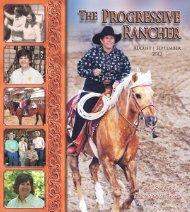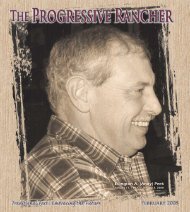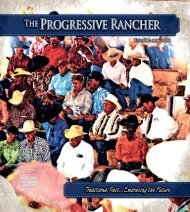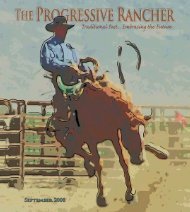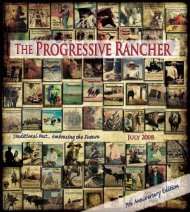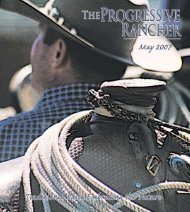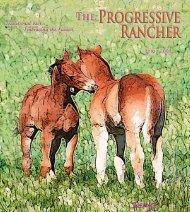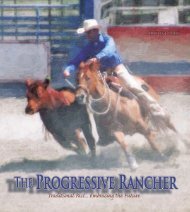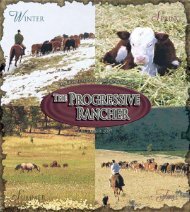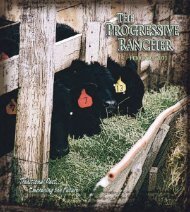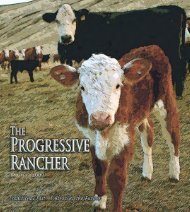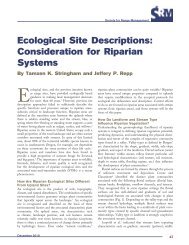NCA 2009 President's Award Recipient - The Progressive Rancher ...
NCA 2009 President's Award Recipient - The Progressive Rancher ...
NCA 2009 President's Award Recipient - The Progressive Rancher ...
Create successful ePaper yourself
Turn your PDF publications into a flip-book with our unique Google optimized e-Paper software.
Federal<br />
Coordination with County Plans<br />
Federal Agencies Are Required To Resolve Inconsistencies<br />
We have all experienced meetings where the earnest federal employees ask us for<br />
what they call the public opinion. This process promises that the voices of citizens will be<br />
included in federal decisions, but what we say very rarely shows up in their documents. <strong>The</strong><br />
agency employees are paid to do such things as consultation, cooperation, collaboration,<br />
and coordination, but they are not instructed to incorporate what they hear into their plans<br />
or regulations. However, words are important, and the word “coordination” has more than<br />
one meaning in the federal vocabulary.<br />
Federal laws also require that Federal agencies “coordinate” their activities on federally<br />
controlled lands with plans prepared by state and local units of government. That<br />
means federal proposals are to be consistent with the policy of local government or clearly<br />
explain why they are taking actions that conflict with official local plans.<br />
In this context, “coordinate” means the action that federal agencies are required to take<br />
to resolve inconsistencies between a federal proposal and an official local plan or policy.<br />
Webster’s Dictionary defines “coordinate” as an action between two parties of equal rank,<br />
importance, or degree. Congress directs the federal agencies to place a county on an equal<br />
footing with the federal agency. In other words coordination is negotiation on a government<br />
to government basis and is not just a form of public input.<br />
First the local community must write a natural resource plan or strategy that describes<br />
the local environment and what land uses are endorsed locally within federal and state<br />
lands. Most of the local plans have been prepared by a committee selected by a County<br />
Commission, although some are being prepared by other local units of government such<br />
as Conservation Districts.<br />
A local environment consists of the natural features such as air, water, plants and<br />
soils; it also includes farms, ranches, mines, retail business, industry, and recreational<br />
pursuits. <strong>The</strong> local strategy describes the current custom, culture, and economy and what<br />
is acceptable to the community. Once it is written, the local government must notify the<br />
federal agencies that an officially approved plan has been adopted and usually that includes<br />
providing the agency with a copy of the plan.<br />
Bureau of Land Management, U.S. Forest Service and<br />
NACo Renew Public Lands Management Partnership<br />
Sign MOU to Continue, Strengthen Working Relationship<br />
WASHINGTON, D.C. – <strong>The</strong> Bureau of Land Management (BLM), the U.S. Forest Service<br />
(FS) and the National Association of Counties (NACo) have officially renewed their<br />
longstanding partnership that allows them to tackle public lands issues across boundaries.<br />
By signing the Memorandum of Understanding, the BLM and FS recognize the important<br />
role counties play in locally based decision-making and the need to emphasize a<br />
landscape-level approach across local, state and federal boundaries.<br />
<strong>The</strong> agreement, signed March 3, establishes a framework for the Bureau, the Forest<br />
Service and NACo to work cooperatively to address fire, weed management, planning and<br />
other areas of common concern, as well as seek creative solutions to issues impacting local<br />
communities such as recreation, grazing, wild horses and burros and energy development.<br />
It ensures that broad lines of communication are opened to county officials to contribute to<br />
federal land management initiatives and policies. At a national and local level, the groups<br />
will collaborate to proactively address potential conflicts and achieve results that benefit<br />
each organization.<br />
“Counties are key partners on-the-ground in the successful management of public<br />
lands,” BLM Principal Deputy Director Neil Kornze said. “<strong>The</strong> BLM values the spirit of<br />
partnership, goodwill and cooperation we have enjoyed in this longstanding relationship.”<br />
“It’s essential that we continue our strong, productive partnership with the National<br />
Association of Counties,” said U.S. Forest Service Chief Tom Tidwell. “We appreciate the<br />
association’s interest and participation in the wide variety of land management issues we<br />
face every day on forests and grasslands cross the country.”<br />
By Floyd W. Rathbun, Certified Range Management Consultant, Fallon, Nevada<br />
Authority for local Natural Resource Strategies in Nevada was established over<br />
twenty years ago with the passage of SB40. Soon after passage, several Nevada counties<br />
established what were called Public Land Use Advisory Committee and completed what<br />
were called public lands plans. Definition of the term “public lands” has caused some real<br />
confusion so emphasizing natural resource qualities is a way to avoid the controversy. SB40<br />
is codified in the Nevada Revised Statutes within NRS321.<br />
Local Process:<br />
1. Establish by ordinance a Natural Resource Advisory Committee (NRAC).<br />
2. Select the committee members that best represent your area. For example Owyhee<br />
County, Idaho, ordinance specifies that people will be appointed to the committee on the<br />
basis of: “...involvement in, an interest in, and expertise in the various multiple uses of<br />
the federally and state managed lands and the custom, culture, and economic stability of<br />
Owyhee County.”<br />
3. Write a land use and natural resource management plan or strategy for lands administered<br />
by federal and state agencies, in order to clearly communicate the policies of your<br />
County to these other entities.<br />
4. Save time and effort by following the examples of communities which have been<br />
successful, including: Eureka County Nevada, Pershing County Nevada, Owyhee County<br />
Idaho, Modoc County California, Wallowa County Oregon, and Walla Walla County<br />
Washington. Copies of their plans and other materials are available for <strong>The</strong> County to use.<br />
5. Officially approve the completed strategy by ordinance, deliver the plan to each<br />
of the various federal and state agencies, and be prepared to insist that the policies of the<br />
County be recognized in accordance with the various federal and state laws.<br />
If the local government has no plan or policy then it (the County) is just one more voice<br />
that the federal agents will ignore as public input.<br />
On the other hand, an official local plan or strategy can be used to require the government<br />
employees to stay within the scope of their authority and often provides the best<br />
course of action.<br />
A local planning committee is much more likely to find real solutions for real problems.<br />
NACo President Chris Rodgers said he is pleased that our federal partners recognize<br />
the unique role and perspective counties play in the management of public lands. “This<br />
agreement strengthens our intergovernmental relationships and ensures that county officials<br />
have input on federal decisions affecting counties and communities.”<br />
<strong>The</strong> BLM is a federal agency that manages approximately 245 million acres of public<br />
land, primarily in the West, and 700 million acres of federal mineral resources. In addition,<br />
the BLM is responsible for managing public lands scattered throughout the 31 states bordering<br />
on, and east of the Mississippi River. <strong>The</strong> agency’s mission is to sustain the health,<br />
diversity, and productivity of these public lands for the use and enjoyment of present and<br />
future generations.<br />
<strong>The</strong> Forest Service is a land and resource management agency of the U.S. Department<br />
of Agriculture responsible for managing and protecting approximately 193 million acres<br />
of public lands. <strong>The</strong> Forest Service provides leadership in the management of the Nation’s<br />
state and private forests, forest research, and international assistance for the protection and<br />
sound management of the world’s forest resources.<br />
National Association of Counties is a national organization that represents county<br />
governments in the United States. Founded in 1935, NACo provides essential services to<br />
the nation’s 3,069 counties. NACo advances issues with a unified voice before the federal<br />
government, improves the public’s understanding of county government, assists counties<br />
in finding and sharing innovative solutions through education and research, and provides<br />
value-added services to save counties and taxpayers money.<br />
www.progressiverancher.com <strong>The</strong> <strong>Progressive</strong> <strong>Rancher</strong><br />
April 2013 25



